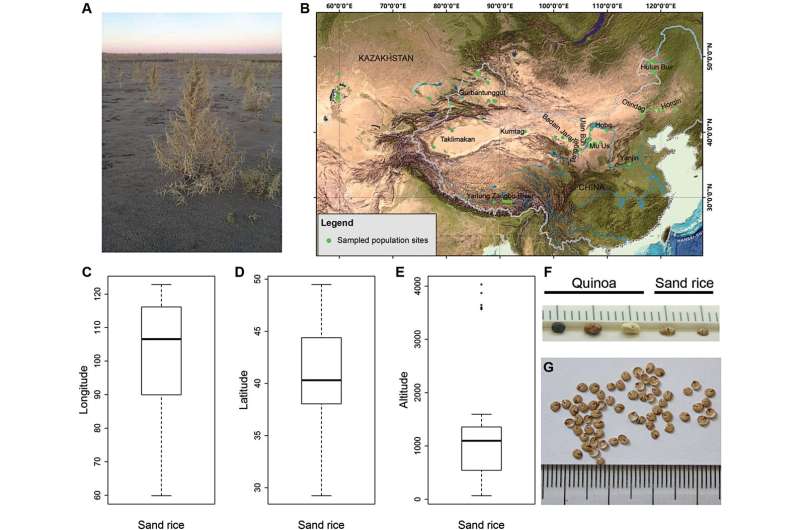Geographic distribution of sand rice. (A) A mature sand rice plant in Xin Barag Left Banner, Hulun Buir. (B) Geographic distribution of sand rice in China and Kazakhstan. The background imagery is reproduced from GEBCO_2014 Grid, version20150318 (http://www.gebco.net). Boxplots of (C) longitude, (D) latitude, and (E) altitude of the 68 sand rice populations studied. (F) Comparison of seed size between quinoa and sand rice, and (G) seed phenotype of sand rice. Credit: Journal of Experimental Botany (2022). DOI: 10.1093/jxb/erac231
Seed size is an important functional trait affecting multiple aspects of plant fitness and is also one of the most important agronomic traits in the process of plant domestication.
Sand rice (Agriophyllum squarrosum) is a promising climate-resilient crop with exceptional nutritional value and high-stress tolerance. Large intraspecific seed size variation across its natural populations makes sand rice an optimal model to dissect the ecological mechanism in adaptation to the desert ecosystems.
A research team from the Northwest Institute of Eco-Environment and Resources of the Chinese Academy of Sciences performed experiments to identify the effects of geographic, climatic, and local environmental variables on seed size variation across sand rice natural populations.
The related results were published in the Journal of Experimental Botany.
The researchers examined the geographic pattern of seed size variation across 68 natural populations from Kazakhstan and China, covering most of the distribution range of sand rice, and found seed size variation exhibits a longitudinal (west-to-east) cline across its natural range.
Through model construction and variance decomposition analyses, they further found that the average annual precipitation and minimum precipitation of collection-year significantly influenced the seed size variations. Precipitation is the main driver that underlies the longitudinal pattern of seed size across the distribution range of sand rice.
Furthermore, the researchers carried out a common garden experiment to evaluate the genetic and plastic effects on seed size using the large- and small-seeded individual groups. Results showed that large-seeded individuals from the eastern sandy fields in China exhibited strong adaptive plasticity and better performance at seedling establishment stage, and thus merited the following genetic domestication and natural breeding of sand rice.
More information: Pengshan Zhao et al, Precipitation and local environment shape the geographic variation of seed size across natural populations of sand rice (Agriophyllum squarrosum), Journal of Experimental Botany (2022). DOI: 10.1093/jxb/erac231
Journal information: Journal of Experimental Botany,
Provided by Chinese Academy of Sciences
























